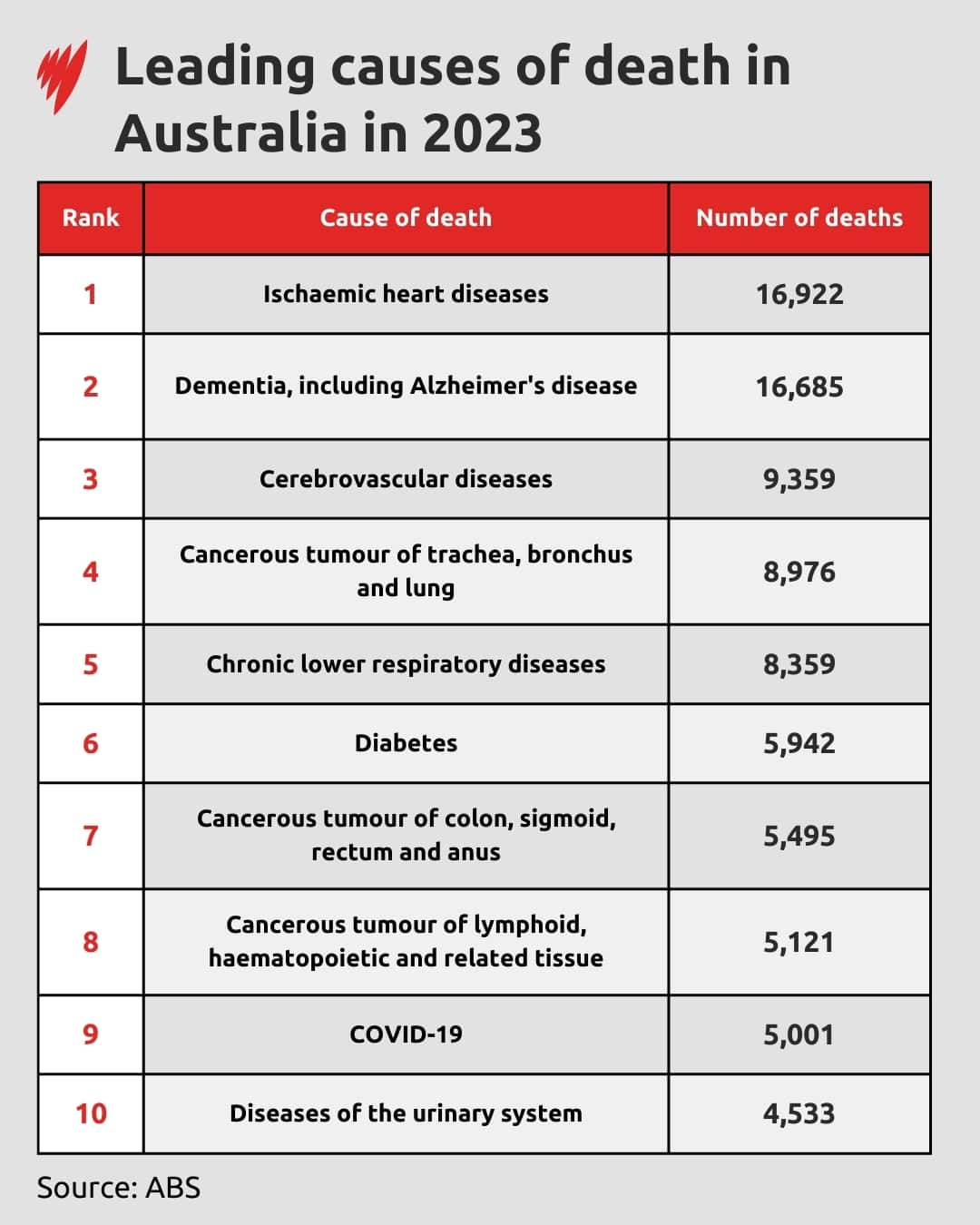Key Points
- The Australian Bureau of Statistics has released data on the leading causes of death for 2023.
- Ischaemic heart disease is the top cause of death in Australia, but dementia is quickly catching up.
- Over the past 50 years, the mortality rate for dementia has increased by more than 842 per cent.
This article contains references to suicide.
Australians are living longer than ever, and as our society ages, the leading cause of death could soon change.
According to new data released by the Australian Bureau of Statistics (ABS), ischaemic heart disease (a medical condition that affects the heart due to reduced blood flow) is the top cause of death in Australia and has led to 16,922 of the 183,131 deaths registered in Australia in 2023.
But the number of deaths caused by dementia is quickly rising, with the condition leading to 16,685 deaths last year.
Cerebrovascular disease (medical conditions that affect blood flow to the brain) was the third leading cause, while lung cancer and chronic lower respiratory diseases were fourth and fifth, respectively.
Ischaemic heart disease and dementia were the top two causes of death in Australia in 2023. Source: SBS News
Heart disease declining as dementia rises
While ischaemic heart disease remains the leading cause of death in Australia, rates are declining, according to the ABS.
In 2024, it accounted for 9.2 per cent of deaths, while at its peak in 1968, it accounted for over 30 per cent of deaths. At that time, dementia accounted for 0.2 per cent of deaths, compared to 9.1 per cent in 2023.
It is the leading cause of death for Australian women, representing 12.2 per cent of all female deaths and 6.4 per cent of male deaths.
Dementia is most common among people aged over 65, and the median age of death due to dementia is 88.7. As Australia’s population ages, this has led to more deaths due to dementia.
The rate of dementia is increasing as Australia’s population ages. Source: SBS News
Over the past 50 years, the mortality rate for dementia has increased by more than 842 per cent, while the rate for ischaemic heart disease has decreased by 87.9 per cent.
There is no cure for dementia, and Dementia Australia CEO Professor Tanya Buchanan said the terminal nature of the disease is poorly understood.
“As dementia edges closer to becoming the leading cause of death of Australians, it is crucial that we act now to focus on the brain health of the nation as well as provide more targeted, effective support to those impacted by dementia,” she said.
“Taking this dual approach will ensure we are working towards reducing the impact of dementia in the future.”
How many people are dying from COVID-19 in Australia?
In 2023, the number of deaths caused by COVID-19 in Australia was 5,001, making it the ninth-leading cause of death in the country.
The virus caused 9,862 deaths in 2022, making it the third-leading cause of death that year.
In 2023, the World Health Organization declared COVID-19 was no longer an international health emergency.
The people dying in ‘potentially avoidable’ circumstances
The ABS also released data on ‘potentially avoidable’ mortality, which covers deaths of people under 75 that could have been avoided through care or intervention.
This includes specific types of cancer and medical conditions or infectious diseases, as well as ‘external causes’ such as accidents, suicides and assaults.
In 2023, there were 28,112 avoidable deaths, including 17,805 males and 10,307 females.
This marked a slight decrease from 2022 when there were 28,935 potentially avoidable deaths.
How many Australians are dying by suicide?
This year’s release included insights into intentional self-harm deaths, including remoteness area for the first time.
There were 3,214 deaths initially classified as being due to suicide in 2023, making it the 16th leading cause of death. Of these deaths, 75.3 per cent were male.
The median age for death by suicide was 45.5.
Suicide rates were higher in regional and remote Australia, which the ABS said could be influenced by social, economic, health and environmental conditions.
Substance abuse, including alcohol use, was most commonly mentioned as a risk factor in remote and very remote locations, along with problems relating to legal circumstances.
For people living in outer regional and remote areas, problems relating to primary support networks — including the death of a loved one or problems in relationships — were common risk factors
Suicide rates were also higher among Aboriginal and Torres Strait Islander people, with intentional self-harm the fifth-leading cause of death.
Readers seeking crisis support can contact Lifeline on 13 11 14, the Suicide Call Back Service on 1300 659 467 and Kids Helpline on 1800 55 1800 (for young people aged up to 25) or find an . More information and support with mental health is available at and on 1300 22 4636.
supports people from culturally and linguistically diverse backgrounds.
Resources for young Aboriginal and Torres Strait Islanders can be found at .


